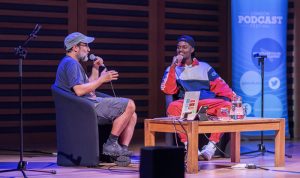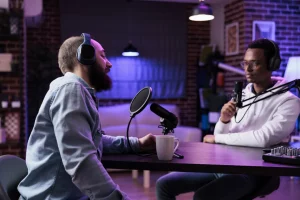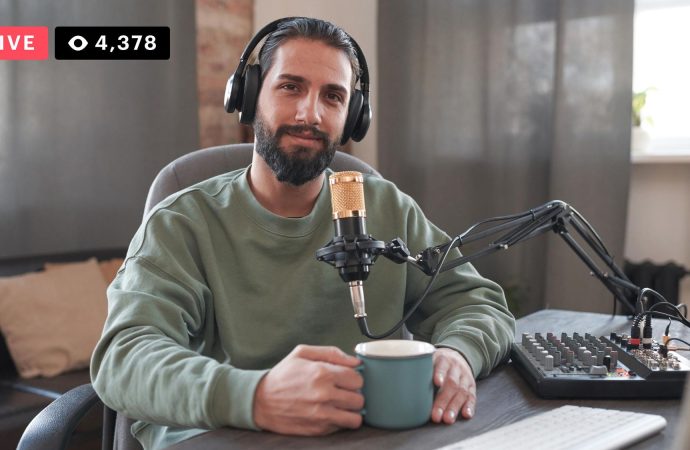Introduction Podcasting has become a major player in the entertainment industry, revolutionizing the way audiences consume content. With the rise of podcasts, live entertainment, once defined by concerts, theater, and sports events, is now facing both challenges and new opportunities. This article explores the trends and challenges in the intersection between podcasting and live entertainment.
Introduction
Podcasting has become a major player in the entertainment industry, revolutionizing the way audiences consume content. With the rise of podcasts, live entertainment, once defined by concerts, theater, and sports events, is now facing both challenges and new opportunities. This article explores the trends and challenges in the intersection between podcasting and live entertainment.
The Rise of Podcasting

Image by: Yandex.com
1. Podcasts as a New Medium
Podcasts have grown tremendously over the past decade, offering a platform for storytellers, influencers, and brands to connect with audiences in a more intimate way. The flexibility of podcasting, where listeners can tune in anytime and anywhere, has driven its popularity. According to recent reports, there are over 2 million podcasts available globally, covering diverse topics ranging from comedy to news and education.
2. Why Podcasting Works
The low cost of production, ease of distribution, and the ability to target niche audiences have made podcasting a go-to platform for content creators. Unlike live events, which require substantial investment in venues, equipment, and logistics, podcasts can be created with just a microphone and editing software. Additionally, advertisers have found value in podcasts because of the highly engaged and loyal audiences they attract.
Podcasting’s Growing Popularity
Podcasting has become one of the fastest-growing forms of entertainment. It allows people to listen to content whenever they want, making it incredibly convenient. Whether someone is driving, working out, or relaxing at home, they can easily access podcasts on their phone or computer. This convenience is a big reason why podcasting has taken off in recent years.
Podcasts Cover Every Topic
Podcasts are great because they cover every topic you can think of. From comedy and true crime to sports and self-help, there’s a podcast for everyone. This wide variety attracts all kinds of listeners. You can easily find a podcast that matches your interests and dive into new topics whenever you want. The wide range of options is one of the reasons podcasting continues to grow rapidly.
Live Shows Offer Unique Experiences
While podcasts are easy to listen to, live shows offer something podcasts can’t—real-time experiences. There’s something special about being at a live concert, comedy show, or theater performance. The energy in the room, the excitement of being there in person, and the connection with the performer create a one-of-a-kind experience. Live entertainment still holds a strong place in the industry because of these unique moments.
Live Entertainment: Adapting to the Digital Age

Image by: Yandex.com
1. The Shift to Hybrid Events
Live entertainment has been impacted by the growth of digital platforms, including podcasts. Many live events are now offering hybrid experiences, combining in-person and online components. For example, concerts or stand-up comedy shows are streamed live, allowing people who cannot attend in person to participate virtually. This hybrid approach broadens the audience reach while maintaining the energy and atmosphere of live performances.
2.Audience Expectations Are Evolving
Audiences today expect more than just the event itself. They want interaction and the ability to engage with performers before, during, and after events. Podcasting offers this engagement in a way that live performances may not always deliver. For instance, after a live concert, fans can tune in to a podcast featuring the artist discussing the show or offering behind-the-scenes stories.
Easy and Affordable to Produce
One reason podcasts are so popular with creators is that they’re easy and affordable to make. All you really need is a microphone, some basic editing tools, and an idea. This is much cheaper than putting on a live show, which requires venues, equipment, and staff. Because podcasts are so low-cost, many people have been able to start their own shows, bringing more diverse voices and stories into the entertainment world.
New Ways to Engage Audiences
Today’s audiences want more than just to watch or listen—they want to interact. Podcasts have made it easier for listeners to engage with creators through social media, live Q&A sessions, and feedback opportunities. Live entertainment is also trying to add more interactive elements, like apps that let concert-goers vote on songs or ask questions to performers. This interaction helps create a closer connection between fans and artists.
The Challenge of Attention
One of the biggest challenges live entertainment faces today is competition for people’s attention. Podcasts are available anytime, anywhere, so people can listen whenever it suits them. Live entertainment, on the other hand, requires people to set aside a specific time to attend. This means that many people, especially those with busy schedules, might choose the flexibility of a podcast over the commitment of a live event.
Challenges Facing Live Entertainment

Image by: Yandex.com
1. Competing for Attention
As podcasts continue to gain popularity, live entertainment faces increased competition for audience attention. Podcasts, with their on-demand nature, allow listeners to consume content whenever it suits them, while live entertainment requires a specific time commitment. This shift in consumption habits is one of the major challenges live entertainment must overcome.
2. Adapting to Technological Advancements
With advancements in technology, virtual and augmented reality (VR and AR) are becoming part of the live entertainment experience. While this presents exciting new possibilities, it also means that traditional live entertainment must adapt quickly. Podcasts have already capitalized on these technologies with immersive audio experiences, and live events will need to find innovative ways to keep up.
Adapting to Technology
Technology is changing both podcasting and live entertainment. Podcasts have already embraced new tech, like immersive audio and virtual reality, to make the listening experience more engaging. Live events are starting to use these technologies too, but it’s more expensive and harder to pull off. However, both industries need to keep up with technological advancements to stay relevant and exciting for their audiences.
Trends Shaping the Future of Both Podcasting and Live Entertainment

Image by: Yandex.com
1. Interactive Content
A major trend is the rise of interactive content. Podcasts are now incorporating elements that allow listeners to participate more actively, such as live Q&A sessions, fan polls, and feedback segments. In live entertainment, interactivity is also gaining traction. For example, some music festivals offer apps that let fans choose part of the setlist or vote on specific elements of the performance.
2. Cross-Platform Collaborations
Another trend is the collaboration between podcasters and live performers. Many popular podcasts now feature live tours, where creators perform in front of a live audience. Conversely, live entertainment producers are tapping into the popularity of podcasts by incorporating podcast-like segments or backstage interviews into their shows. These collaborations offer both podcasting and live entertainment new revenue streams and the ability to reach larger audiences.
3. Technological Advancements
AI and Machine Learning: These technologies will play a significant role in content creation, personalization, and audience analytics.
Blockchain: Potential applications include transparent royalty distribution and new monetization models.
4. Audience Engagement
Community Building: Both podcasting and live entertainment will increasingly focus on fostering strong, engaged communities.
Cross-Platform Synergies: Collaboration between different media platforms will enhance content delivery and audience interaction.
Comparative Analysis of Podcasting and Live Entertainment
| Aspect | Podcasting | Live Entertainment |
|---|---|---|
| Production Costs | Low cost of production | High cost, including venues and logistics |
| Audience Engagement | Ongoing interaction through episodes | Limited to specific events and performances |
| Flexibility | Available on demand | Requires scheduled attendance |
| Reach | Global reach, accessible to anyone | Local and limited by venue capacity |
| Revenue Streams | Ads, subscriptions, sponsorships | Ticket sales, merchandise, sponsorships |
| Technological Integration | High, with immersive audio and AR/VR | Increasing, but more expensive to implement |
| Longevity | Can be consumed at any time | Limited to event duration |
Analysis of Podcasting and Live Entertainment Trends and Challenges
| Category | Podcasting | Live Entertainment | Challenges |
|---|---|---|---|
| Audience Behavior | Niche, highly loyal, and flexible listeners | Broad but requires time and physical presence | Competing for time and attention |
| Revenue Generation | Advertising, sponsorships, and listener support | Primarily ticket sales and in-person engagement | Economic downturns affect attendance |
| Technological Impact | Embracing AR, VR, and interactive audio | Slower to adopt, but gaining ground with hybrid models | High cost of integrating new tech |
| Growth Opportunities | Continuous content production and cross-platform collaborations | Hybrid events and interactive performances | Balancing digital and live experiences |
Conclusion: The Road Ahead for Podcasting and Live Entertainment
Podcasting and live entertainment, though distinct, are increasingly influencing each other. Podcasting offers a more flexible, affordable, and scalable form of entertainment, while live events offer the irreplaceable excitement of in-person experiences. The future of both lies in innovation and collaboration. Hybrid models, where podcasts and live events combine, are likely to continue growing, providing audiences with both convenience and engagement. As technology evolves, these industries must continue to adapt to meet audience expectations.
















